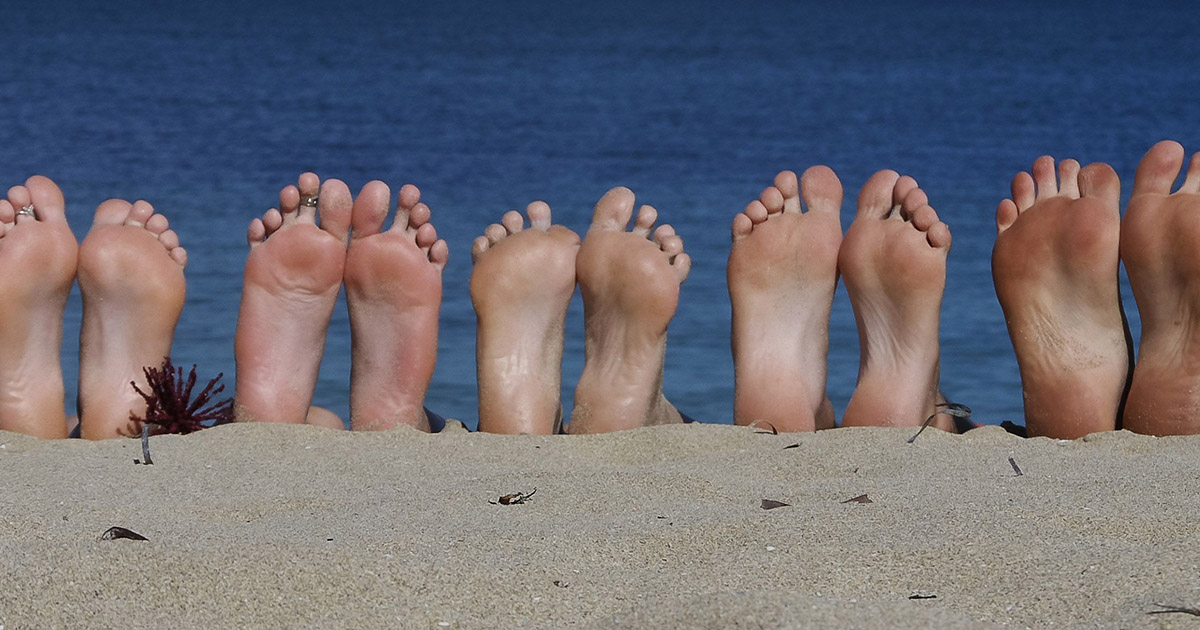
Summer is a perfect time to relax, have fun, and get our feet in the sand. But barefoot beach walking comes with risks.
Risks
Cuts
Even pristine, white beaches can have sharp objects lurking within. Shell fragments, sharp coral, rocks, discarded pieces of glass, metal, and other debris all may be too small to be seen or they might be hiding just underneath. A small cut or scrape can quickly become a serious infection like staph or tetanus. Infection is an even greater danger if you have medical conditions like diabetes, PVD, or neuropathy.
Infections
Cutaneous larva migrans is a skin disease caused by a type of hookworm larvae found in animals. The larvae enter the body—even through unbroken skin. Walking barefoot on the beach or even lying with bare back on the sand can provide opportunity for these little invaders. The infection causes a linear or wavy rash and is common in the Caribbean, Americas, Africa, and Asia.
Hookworm infection
Hookworm infections are found in the tropics, subtropics, and the soil in areas of poor sanitation. The tiny larvae can penetrate unbroken skin, migrate to the lungs, then progress to the gut. Initial infections may be light or even without symptoms. Repeated infections can cause severe hookworm anemia and other complications.
Strongyloidiasis
Strongyloidiasis is a parasitic disease common in wet tropical and subtropical areas, rural areas of South and Central America, Africa, and India. Infection occurs when the larvae enters your skin, usually from the feet, then migrates to the lungs and gut. Unlike hookworm, the larvae are able to mature inside your body, form an invasive filariform, invade skin and maintain in the body indefinitely. Symptoms may include an itchy rash at time of infection, episodes of itchy skin lesions, and non-specific gastrointestinal symptoms. As this infection disseminates through the body, it can cause life-threatening complications years after the initial infection.
Tungiasis
Tungiasis is caused by the jigger flea, which lives in sand in South America, Central America, and West Africa. The flea burrows into skin on the feet, under toenails, or between toes, causing inflammation and ulceration. If left untreated, very serious bacterial infections can occur.
Bites and stings
Jellyfish, snakes, and spiders lurk in the sands of some tropical and subtropical beaches. In addition to the risk of the bite or stings themselves (think scorpion or jellyfish venom), wounds from bites are much more likely to develop into life- and limb-threatening infections quickly.
Have fun while reducing risk
Despite all these risks, a beautiful, sandy expanse can be irresistible. People have been walking barefoot on beaches for thousands of years, and since everyone isn’t hobbling around on one leg it can't be all that risky, right? Well, yes, but that fact is of little comfort to beachgoers that end up with a nasty infection. Here are some suggestions to have fun on the beach while reducing your risk.
Before visiting the beach
- Pack a disinfectant.
- If your tetanus vaccine is not current, visit your health care provider for a new vaccine.
- If you have any type of cut, scratch, or open wound on your feet or legs, you should should not walk barefoot on the beach.
- If you have diabetes, PVD, neuropathy, or any condition that reduces feeling in your feet, do not walk barefoot on the beach.
- Keep your feet smooth. Tiny cracks from calluses can make it even easier for infections to enter your body. Get a professional pedicure to remove heavy calluses.
- Don't walk barefoot on the beach the same day you get a professional pedicure.
While visiting the beach
- Wear beach shoes.
- If you are bitten or stung, disinfect the site immediately. Monitor the site closely and seek medical attention immediately if there there are any signs of infection. Infection from bites and stings spreads quickly; that pin-sized bite can become a huge, infectious abscess within hours.
- Avoid walking or playing in puddles on the beach or in tide pools. Stagnant water is a breeding ground for harmful bacteria.
- Apply sunscreen to your feet and reapply frequently, just as you do to the rest of your skin.
After visiting the beach
- As soon as you walk off the beach, remove your beach shoes to shake out sand, debris, bugs, etc.
- If you notice any strange rashes or symptoms after a beach vacation, seek medical advice from a physician trained in travel medicine.
Protect more than just your feet
- All of these risks apply to the skin on your back as well. Lay on a beach towel rather than letting bare skin come in contact with sand.
- Avoid sitting or laying on the sand while wearing wet bathing suits or clothes, since this can attract larvae.

